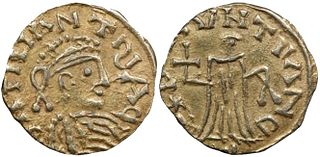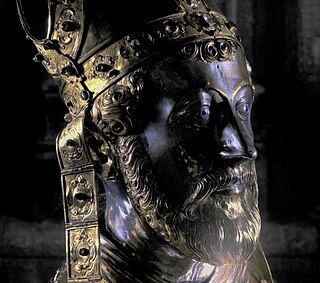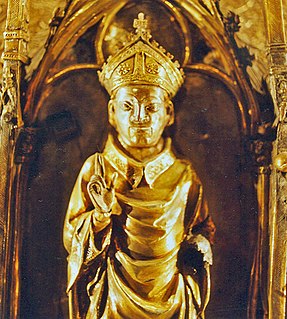The 580s decade ran from January 1, 580, to December 31, 589.

Gregory of Tours was a Gallo-Roman historian and Bishop of Tours, which made him a leading prelate of the area that had been previously referred to as Gaul by the Romans. He was born Georgius Florentius and later added the name Gregorius in honour of his maternal great-grandfather. He is the primary contemporary source for Merovingian history. His most notable work was his Decem Libri Historiarum, better known as the Historia Francorum, a title that later chroniclers gave to it, but he is also known for his accounts of the miracles of saints, especially four books of the miracles of Martin of Tours. St. Martin's tomb was a major pilgrimage destination in the 6th century, and St. Gregory's writings had the practical effect of promoting this highly organized devotion.

Childebert II (c.570–596) was the Merovingian king of Austrasia from 575 until his death in March 596, as the only son of Sigebert I and Brunhilda of Austrasia; and the king of Burgundy from 592 to his death, as the adopted son of his uncle Chilperic.
Palladius was the first bishop of the Christians of Ireland, preceding Saint Patrick; the two were perhaps conflated in many later Irish traditions. He was a deacon and member of one of the prominent families in Gaul. Pope Celestine I consecrated him a bishop and sent him to Ireland "to the Scotti believing in Christ".

Saint Gontrand, also called Gontran, Gontram, Guntram, Gunthram, Gunthchramn, and Guntramnus, was the king of the Kingdom of Orléans from AD 561 to AD 592. He was the third eldest and second eldest surviving son of Chlothar I and Ingunda. On his father's death in 561, he became king of a fourth of the Kingdom of the Franks, and made his capital at Orléans. The name "Gontrand" denotes "War Raven".

Saint Servatius was bishop of Tongeren —Latin: Atuatuca Tungrorum, the capital of the Tungri—. Servatius is patron saint of the city of Maastricht and the towns of Schijndel and Grimbergen. He is one of the Ice Saints. His feast day is May 13.

Gundoald or Gundovald was a Merovingian usurper king in the area of southern Gaul in either 584 or 585. He claimed to be an illegitimate son of Chlothar I and, with the financial support of the Emperor Maurice, took some major cities in southern Gaul, such as Poitiers and Toulouse, which belonged to Guntram, king of Burgundy, a legitimate son of Chlothar I. Guntram marched against him, calling him nothing more than a miller's son and named him 'Ballomer'. Gundovald fled to Comminges and Guntram's army set down to besiege the citadel. The siege was successful, Gundovald's support drained away quickly and he was handed over by the besieged to be executed.
Saint Prætextatus, also spelled Praetextatus, Pretextat(us), and known as Saint Prix, was the bishop of Rouen from 549 until his assassination in 586. He appears as a prominent character in Gregory of Tours’ Historia Francorum. This is the principal source from which information on his life can be drawn. He features in many of its most notable passages, including those pertaining to his trial in Paris and his rivalry with the Merovingian Queen Fredegund. The events of his life, as portrayed by Gregory of Tours, have been important in the development of modern understandings of various facets of Merovingian society, such as law, the rivalry between kings and bishops, church councils, and the power of queens.
Saint Hospitius was a French recluse who, according to tradition, had been a monk in his native Egypt towards the beginning of the 6th century. He immigrated to Gaul and retired to a dilapidated tower, situated on the peninsula of Cap Ferrat, a few miles east of Nice.
Saint Syagrius was a bishop of Autun. His feast day is August 27.
Mummolus, was a Gallo-Roman patrician and prefect who served Guntram, King of Burgundy, as a general in the 6th century.
Eufronius or Euphronius was the eighth Bishop of Tours; he served from 555 to 573, and was a near relative of Gregory of Tours.

The former French diocese of Saintes existed from the 6th century to the French Revolution. Its bishops had their see in the cathedral of Saintes in western France, in the modern department of Charente-Maritime. After the Concordat of 1801, the diocese was abolished and its territory passed mainly to the Diocese of La Rochelle, the name of which was changed in 1862 to the present Diocese of La Rochelle and Saintes.

Saints Ferreolus and Ferrutio are venerated as martyrs and saints by the Catholic Church, especially in Besancon where they are honored as its patron saints.
Gaul was an important early center of Latin Christianity in late antiquity and the Merovingian period. By the middle of the 3rd century, there were several churches organized in Roman Gaul, and soon after the cessation of persecution the bishops of the Latin world assembled at Arles, in AD 314. The Church of Gaul passed through three dogmatic crises in the late Roman period, Arianism, Priscillianism and Pelagianism. Under Merovingian rule, a number of "Frankish synods" were held, marking a particularly Germanic development in the Western Church. A model for the following Frankish synods was set by Clovis I, who organized the First Council of Orléans (511).
Saint Theonistus is a saint venerated by the Catholic Church. Theonistus is venerated with two companions, Tabra and Tabratha. Medieval documents give accounts of his life, which are contradictory and confused.

Saint Palladius of Embrun was a 6th-century bishop of Embrun. Born to a Christian family, he studied under Catulin, bishop of Embrun, who had attended the Council of Épaone in 517. When the Arians and Sigismund of Burgundy opposed the council, Catulin was exiled to Vienne. Palladius accompanied him there, and took the opportunity to extensively study Scripture. Palladius was ordained a priest and, according to legend, gained the gift of prophecy. He is said to have predicted the fall and death of Sigismund. Catulin died around 518, and Palladius would later be elected bishop of Embrun. During his episcopate he built numerous churches, in Chorges, Sauze, and Rama, as well as sanctuaries dedicated to Saint Martin of Tours, and Saints Vincent, Orontius, and Victor, as well as to Genesius of Arles. One source states that Palladius "possessed an exceptional efficacy in obtaining whatever he petitioned God for." Many miracles were attributed to him, and, besides the gift of prophecy, he enjoyed a "mystical familiarity with the angels... [and] successfully defeated the machinations of the devil simply by making the sign of the cross."

Saint Julian of Brioude was a 4th-century martyr from the Auvergne region of France. Although the main focus of his worship was in the small village of Brioude, he was originally from the city of Vienne, and also associated with Clermont. He was most famous through his association with an aristocratic family of bishops of the time, his most notable proponents being St. Gallus of Clermont and St. Gregory of Tours. Gregory wrote a vita of Julian, but his attempts to expand the saint's cult from the Auvergne to Touraine and Aquitaine were unsuccessful, and Julian is now only remembered through his basilica in the town of Brioude itself.

November 16 - Eastern Orthodox liturgical calendar - November 18

Justus of Lyon was the 13th Bishop of Lyon. He succeeded Vérissime in the mid-4th century. He is venerated as a saint by both the Catholic and the Orthodox Church, with a feast day on 2 September. Around 350, Justus was made Bishop of Lyon. As bishop of the capital of Gaul, he was among the participants of the Council of Valencia of 374 regarding religious discipline of the clergy and the faithful. He later became a hermit.











